Right of first refusal instead of deed restriction…
[ By Mark Reaman ]
Not every local organization or entity is dealing with providing affordable housing for their employees in the same way, and the Crested Butte Fire Protection District has taken a different tact than most in at least one situation involving the top administrator. While some like the Gunnison Valley Rural Transportation Authority (RTA) are purchasing multiple units in public and private workforce housing developments, others like the town of Crested Butte have purchased or built units ranging from single family homes to small rental units in what used to be the Ruby Bed and Breakfast. Employees living in those spaces will pay below market rent or be able to live in the unit during their tenure with the organization as part of their compensation package. Such spaces are being used from everyone from the top administration to hourly seasonal workers.
The Crested Butte Fire Protection District has taken its own course by selling at a discount a lot owned by the district to the district’s chief executive officer with the caveat that the district will have the right of first refusal to repurchase the now developed lot with a cap on the appreciation.
CBFPD CEO Sean Caffrey and his wife are the current owners of the lot located next to the Mt. Crested Butte fire station on Gothic Road. The land was purchased by the district in 2001 for $125,000. It was appraised in 2018 for $200,000 when some neighbors expressed interest in purchasing the property. The transaction never took place and a snow storage easement was added to the property.
The district transferred the land to the Caffreys in January of 2020 for $5,000 plus a $170,000 promissory note. In order for Caffrey to obtain a construction loan, he needed to own the property. Under his development agreement with the district he was obligated to build a house with at least three bedrooms. According to the agreement, Caffrey also had to get his design and budget approved by the district.
“I was obligated to design and build the structure within a few years,” explained Caffrey. “We decided to go with a system-built manufactured home through a dealer in Montrose to save on cost. The design was approved by the CBFPD board in the summer of 2020.” The home was delivered in September of 2021 and is under a temporary certificate of occupancy as some construction is not yet completed.
Caffrey said a big issue in the deal was making sure the CBFPD would either be able to acquire the house or be reimbursed for the full cost of the land if they chose not to acquire it when Caffrey was ready to move.
So under the agreement between the district and Caffrey, he is obligated to pay the mortgage until he leaves his job with the CBFPD, moves or otherwise wants to sell the property. The district will then have the option to buy the house at the cost of construction plus 3% per year in appreciation. According to the development agreement, that appreciation kicks in once a CO is issued. If the CBFPD chooses to not purchase the house, Caffrey can sell the property at market value and keep the proceeds minus the promissory note.
“The 3% figure was chosen to reflect a typical residential deed restriction for for-sale affordable/attainable housing,” Caffrey said. “If the district elects to not purchase the house, I am required to sell it on the open market and the $170,000 promissory note becomes payable to the district as part of the sale. If the district buys the house, the promissory note is cancelled as they essentially get their land back and get the house at the cost of construction plus whatever escalation is allowed.”
Caffrey said the deal seemed to satisfy both parties at the time since it allowed the property to be developed without CBFPD funds while providing he and his family a place to live. “When I leave, the CBFPD will be able to re-acquire the property at an attractive price reflective of the building costs only. If they don’t buy it, the district and its taxpayers will be made whole on the original land transaction price through the promissory note.”
Caffrey described the deal as a “creative approach” to develop what will hopefully become district-owned housing for many years to come. “I would recommend a similar approach to other employers who may own land, have employees in need of housing, yet don’t have the funds to build housing themselves.”
CBFPD board president Chris McCann agreed the approach was creative and worked for all parties. “All the credit for the creativity of the agreement really lies with Sean. He came up with a solution to his housing problem that is really a win for both him and his family and the district,” he said. “I can’t imagine a scenario where the district wouldn’t exercise its right of first refusal should Sean decide to depart, but that would be a discussion for the board at that time.”
 The Crested Butte News Serving the Gunnison Valley since 1999
The Crested Butte News Serving the Gunnison Valley since 1999



